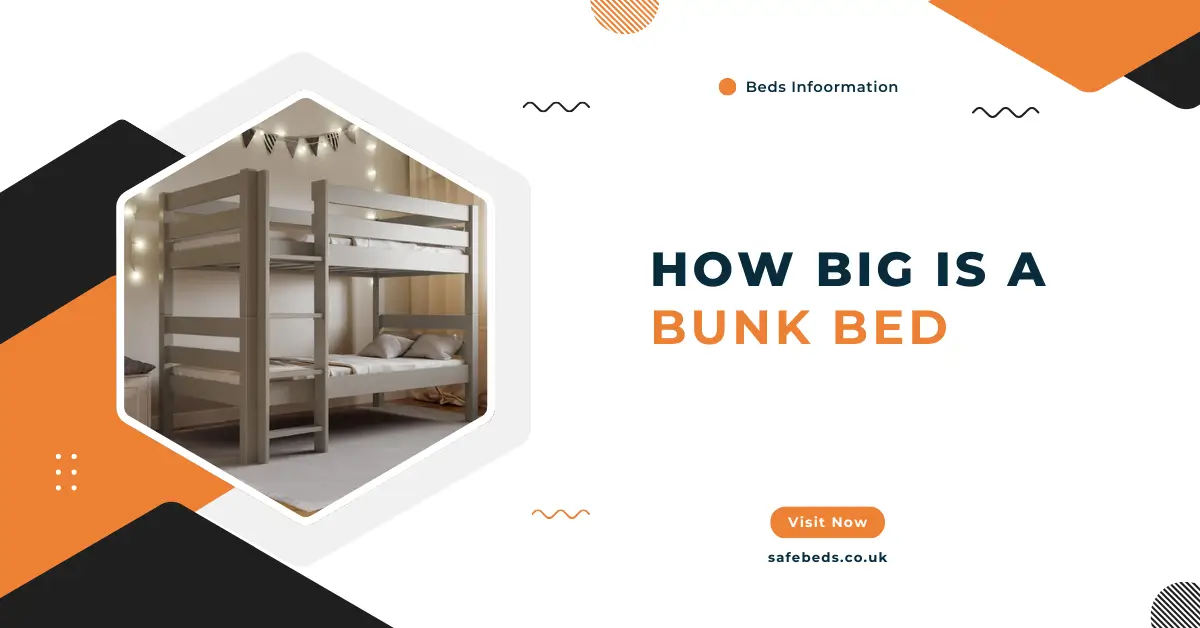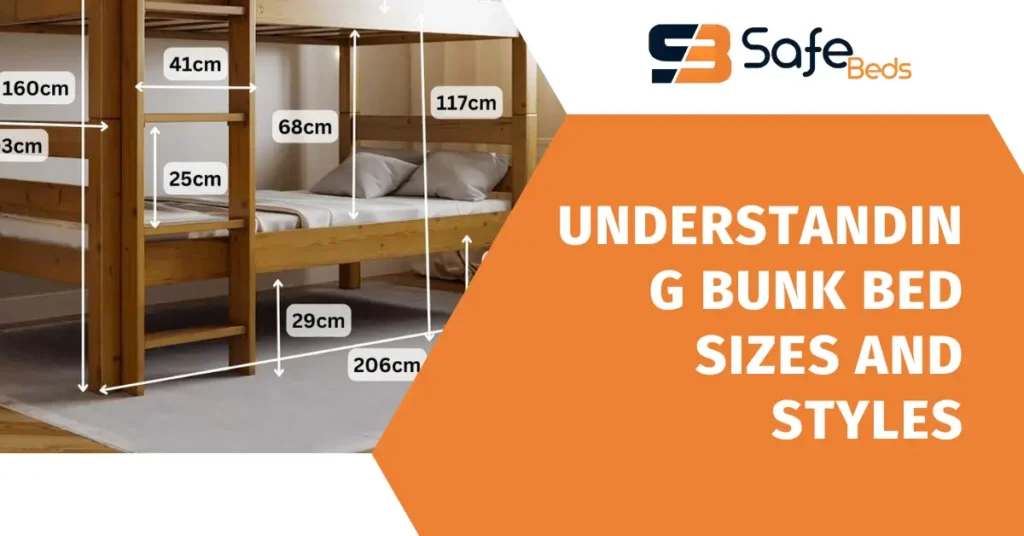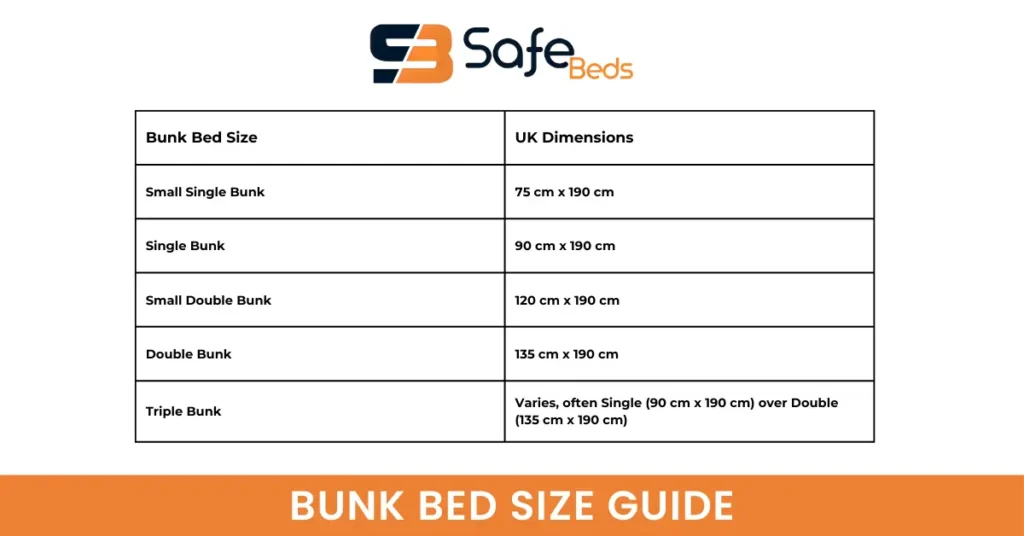How Big is a Bunk Bed? Bunk Bed Dimensions Explained

Bunk beds have become incredibly popular, especially among children who share a room or where space in the bedroom is limited. Their appealing design offers different styles and types to choose from, making it easy to kit a room to fit your specific tastes and requirements.
The dimensions of a bunk bed frame vary based on its style and design, but a standard bunk bed typically measures approximately 39 inches (99 cm) wide, 65 inches (165 cm) tall, and 79 inches (200 cm) long.
When it comes to purchasing this type of bed, one of the most frequently asked questions is, “How big is a bunk bed?” Here’s everything you need to know to make the right choice for your space.
Contents
- 1 || Understanding Bunk Bed Sizes and Styles
- 1.1 || Bunk Bed Sizes: What You Need to Know
- 1.2 || Choosing the Right Size of Bunk Bed
- 1.3 Conclusion
- 1.4 FAQs: (Frequently Ask Questions)
- 1.4.1 1. What are the standard dimensions of a bunk bed?
- 1.4.2 2. How much ceiling height do I need for a bunk bed?
- 1.4.3 3. Can I get a custom-sized bunk bed?
- 1.4.4 4. What is the difference between a standard bunk bed and a triple bunk bed?
- 1.4.5 5. Are bunk beds safe for young children?
- 1.4.6 6. What materials are bunk beds made from?
- 1.4.7 7. How do I know if a bunk bed will fit in my room?
- 1.4.8 8. What should I look for when choosing a bunk bed for adults?
|| Understanding Bunk Bed Sizes and Styles

When considering bunk beds, it’s essential to understand that their size and style can vary based on their intended use. A typical bunk bed consists of two beds stacked on top of each other, with the top bed accessed by a small ladder.
These beds are particularly popular in space-saving rooms where two people need to share a small area. While children often use them, there are also sturdy adult bunk beds designed for more robust settings like youth hostels, hotels, army barracks, or student accommodation.
Beyond the standard configuration, triple beds offer even more versatility. These can include a third bed situated on the floor or hidden inside a drawer that can be pulled out when needed. Some triple bunk beds feature three stacked bunks, while others combine a double bed on the bottom bunk with a single on top.
Given that these beds must support the weight of multiple users, they are constructed from strong, sturdy materials like wood or metal. For adults or larger people, selecting heavy-duty beds and mattresses is crucial to ensure safety and durability.
|| Bunk Bed Sizes: What You Need to Know
When determining how big a bunk bed is, the style and type of the bunk bed frame play a crucial role in dictating its size. A standard bunk bed typically measures around 39 inches (99cm) in width, 65 inches (165cm) in height, and 79 inches (200cm) in length. However, there are variations, such as shorter beds measuring 75 inches in height or 54 inches wide for a full or double bunk.
For those seeking something different, queen bunks measure around 80 inches in length and 60 inches in width, while a king bunk might combine a king bed on the bottom with a twin on top, measuring 76 inches wide and 51.5 inches tall.
The tallest bunk beds, such as triple types, can reach up to 77 inches in height, with the uppermost part being the guard rail. For very young children or those who aren’t comfortable sleeping at a height, low bunk beds that are 50 to 55 inches tall may be ideal.
Keep in mind, though, that bunk beds aren’t recommended for children under four, and those under six should always use the bottom bunk. Additionally, custom-made options are available to meet the specific needs of your establishment or user.
|| Choosing the Right Size of Bunk Bed

When selecting bunk beds, it’s essential to recognize the wide variation in sizes and types available. To ensure an appropriate fit for your room, always consider the size of the space and the needs of its occupants.
Whether you’re furnishing a commercial environment, care home, or domestic setting, the first step is to measure the room. The floor space and height of the room will significantly impact your options for styles and sizes of bunk beds.
For a room to be classified as a bedroom, it should have a minimum floor area of about 70 square feet, with minimum dimensions of around 120 inches x 84 inches x 96 inches. Additionally, pay close attention to ceiling height clearance.
Ideally, there should be 33 inches to 38 inches of clear space from the top bunk mattress to the ceiling so that the occupier can comfortably sit up. Given that the average bunk bed is about 65 inches tall, a ceiling height of around 96 inches is generally suitable.
When positioning a bunk bed, ensure there is a minimum of 30 inches of clear space in front of the ladder. This is crucial for safety, especially when climbing up or down the ladder in the dark. Proper spacing not only provides convenience but also contributes to a safer environment for all users.
Conclusion
In summary, bunk beds are a versatile and space-saving solution, ideal for both children and adults, especially in rooms where space is limited. With a wide range of styles and sizes available, it’s important to carefully consider the dimensions of your room, the height of the ceiling, and the specific needs of the occupants before making a purchase.
Whether you’re choosing a standard bunk bed, a triple bunk, or a custom option, ensuring the bed fits well within the space and meets safety standards will provide a comfortable and durable solution for any setting.
FAQs: (Frequently Ask Questions)
1. What are the standard dimensions of a bunk bed?
Standard bunk beds typically measure around 39 inches in width, 65 inches in height, and 79 inches in length. However, variations exist, with some beds being slightly shorter or wider, such as full or double bunks that are 54 inches wide. These measurements make bunk beds ideal for space-saving in small rooms where two people need to share a bed.
2. How much ceiling height do I need for a bunk bed?
To comfortably fit a bunk bed, you’ll need a ceiling height of around 96 inches. This allows for about 33 to 38 inches of clearance from the top bunk mattress to the ceiling, giving the occupant enough space to sit up without hitting their head. If your room has lower ceilings, consider opting for a low bunk bed, which is typically 50 to 55 inches tall.
3. Can I get a custom-sized bunk bed?
Yes, custom-made bunk beds are available to suit specific room dimensions or particular needs. Whether you need a bunk bed for a commercial setting, like a care home or a youth hostel, or just want something tailored to your space, custom options can provide the perfect solution. Just make sure to measure your room carefully before placing an order.
4. What is the difference between a standard bunk bed and a triple bunk bed?
A standard bunk bed consists of two beds stacked on top of each other, while a triple bunk bed can either feature three stacked bunks or a combination of a double bed on the bottom and a single bed on top. Triple bunk beds are taller, typically reaching up to 77 inches in height, and are designed for rooms with more vertical space.
5. Are bunk beds safe for young children?
Bunk beds are generally not recommended for children under the age of four due to safety concerns. For children aged six and above, it’s safer for them to use the bottom bunk. Always ensure that the top bunk has sturdy guard rails and that there is enough space in front of the ladder—at least 30 inches—to allow safe and easy access, especially in the dark.
6. What materials are bunk beds made from?
Bunk beds are commonly constructed from strong, sturdy materials like wood or metal to support the weight of multiple occupants. Suppose the bunk bed is intended for adults or larger individuals. In that case, it’s crucial to choose a heavy-duty model with a robust frame and mattress to ensure long-lasting durability and safety.
7. How do I know if a bunk bed will fit in my room?
Before purchasing a bunk bed, measure the floor space and ceiling height in your room. For a room to be classified as a bedroom, it should have a minimum floor area of 70 square feet and dimensions of approximately 120 inches x 84 inches x 96 inches. Ensure there is enough clearance around the bed for safety and ease of use.
8. What should I look for when choosing a bunk bed for adults?
When selecting a bunk bed for adults, prioritize models made from heavy-duty materials like solid wood or metal. The bed should have a weight capacity that can accommodate larger individuals, and the mattress should provide adequate support. Additionally, check the height clearance to ensure comfort and safety for adult occupants.
